Charles E W Bean, Diaries, AWM38 3DRL 606/272/1 - 1917 - 1932 - Part 14
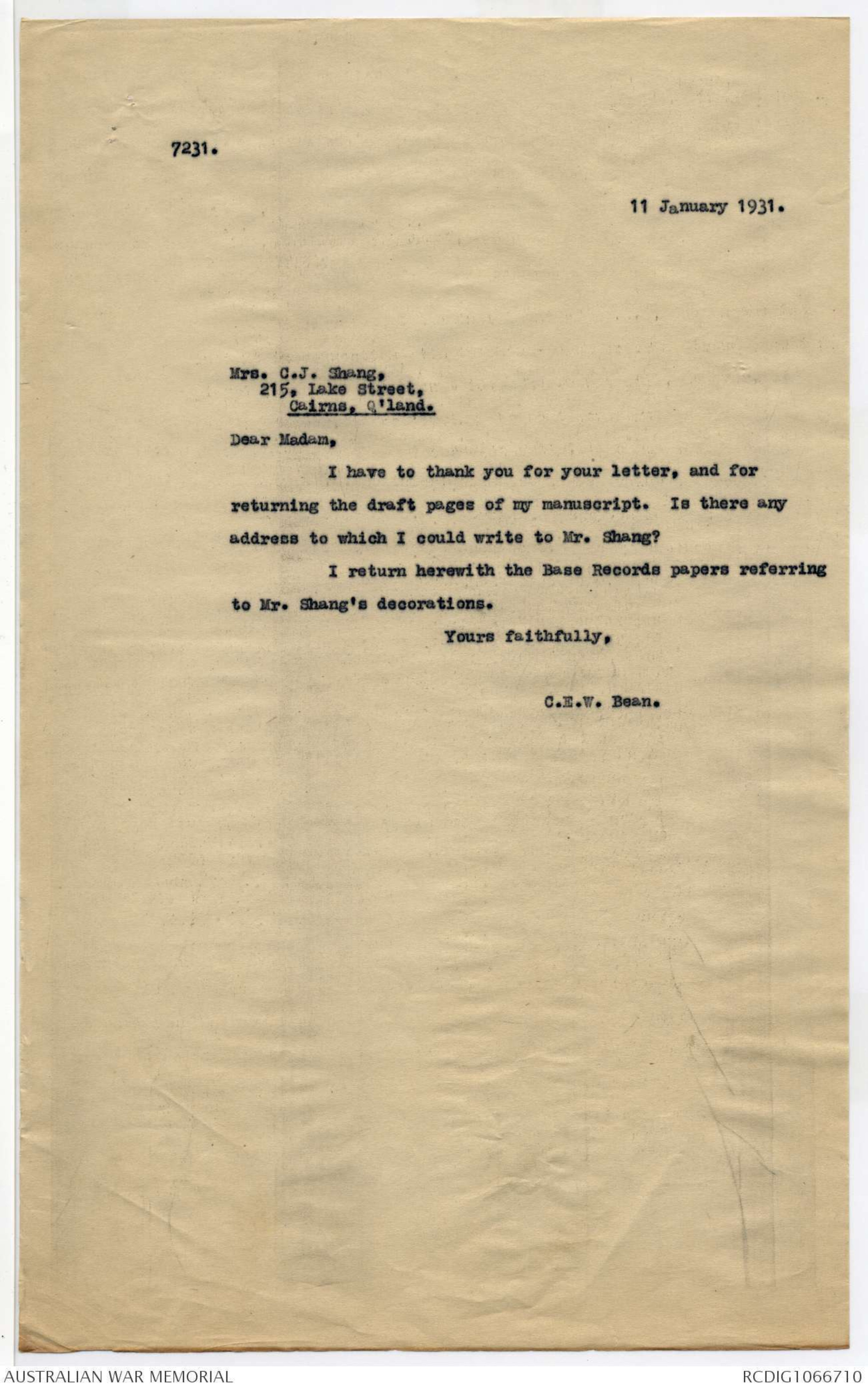
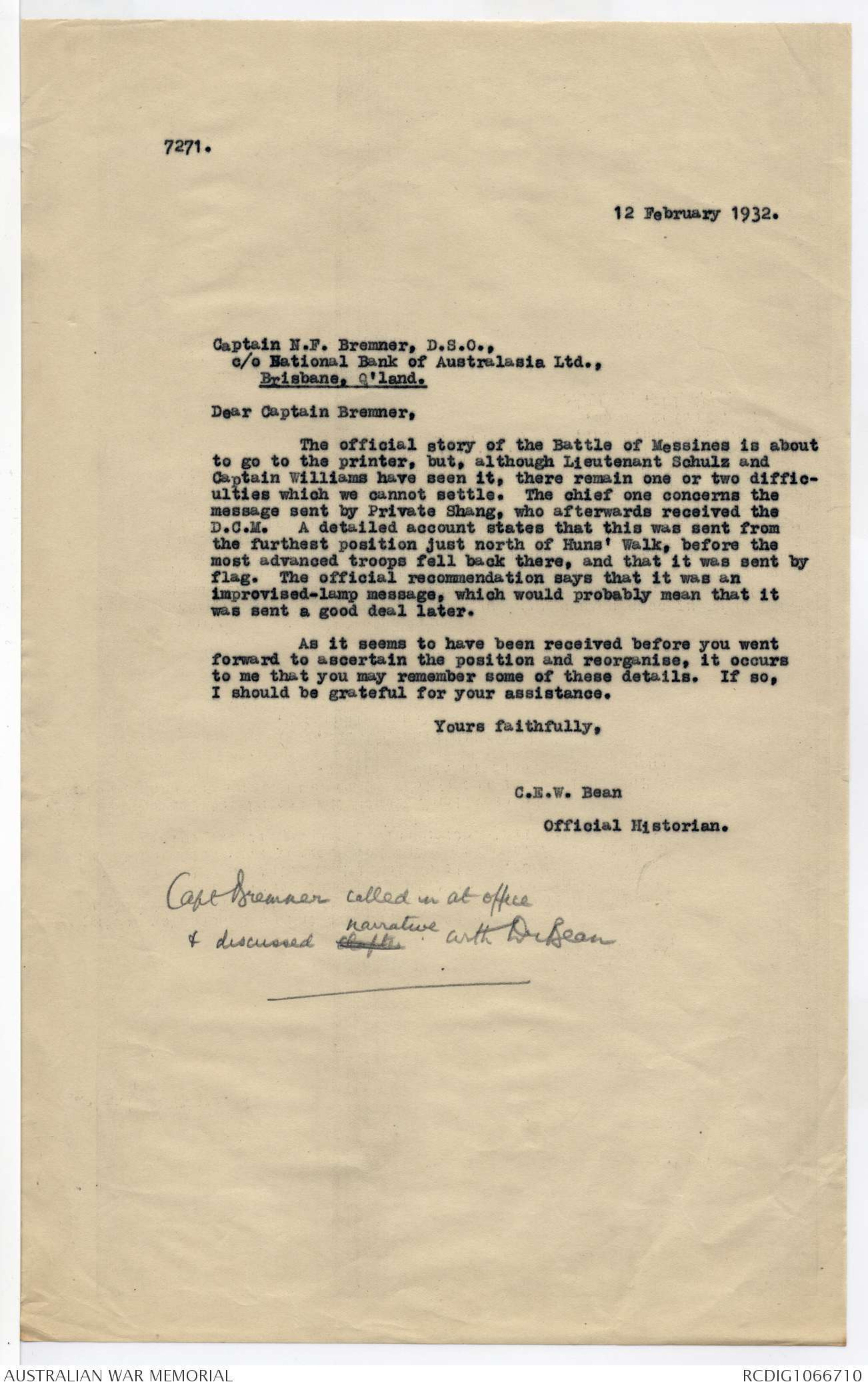

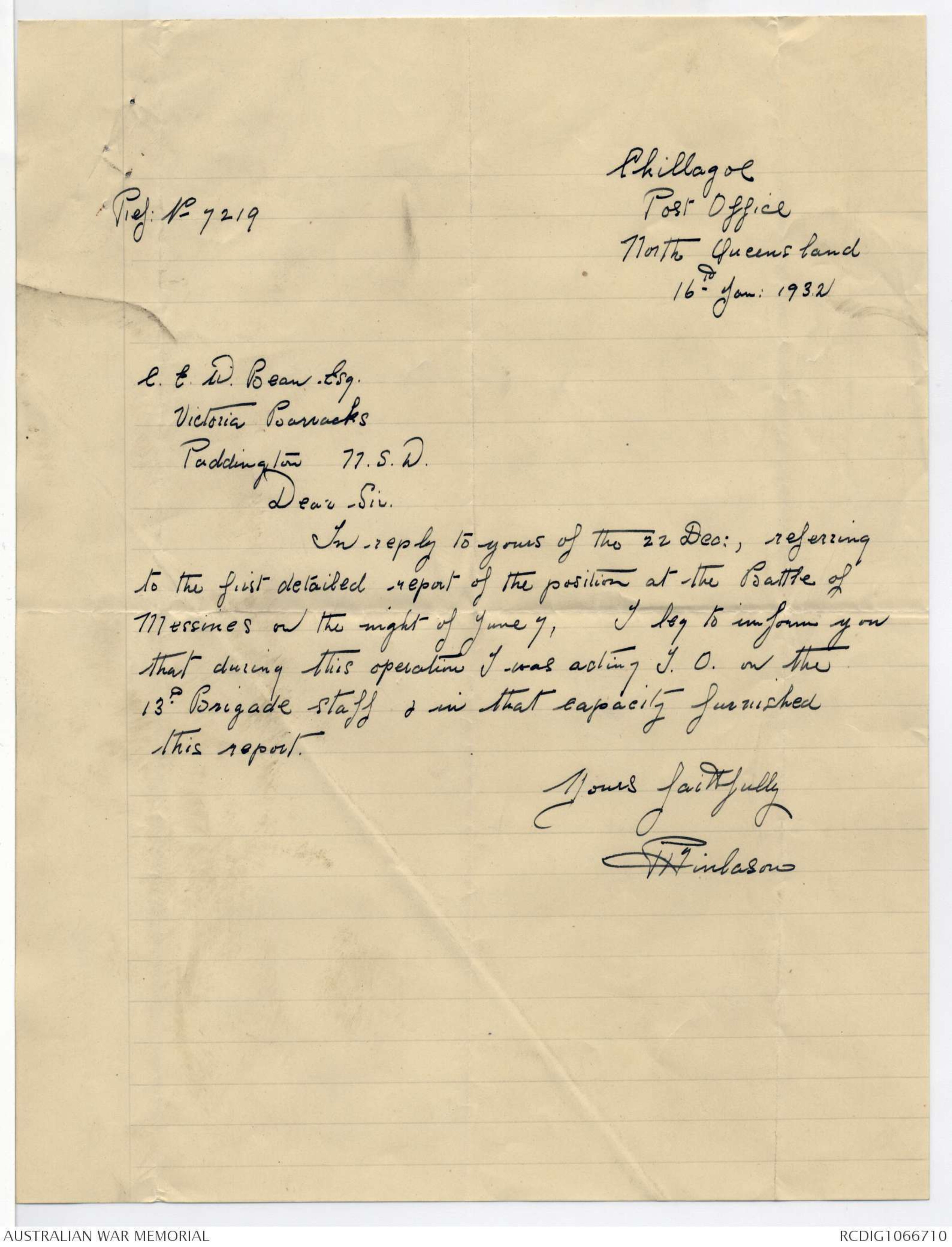
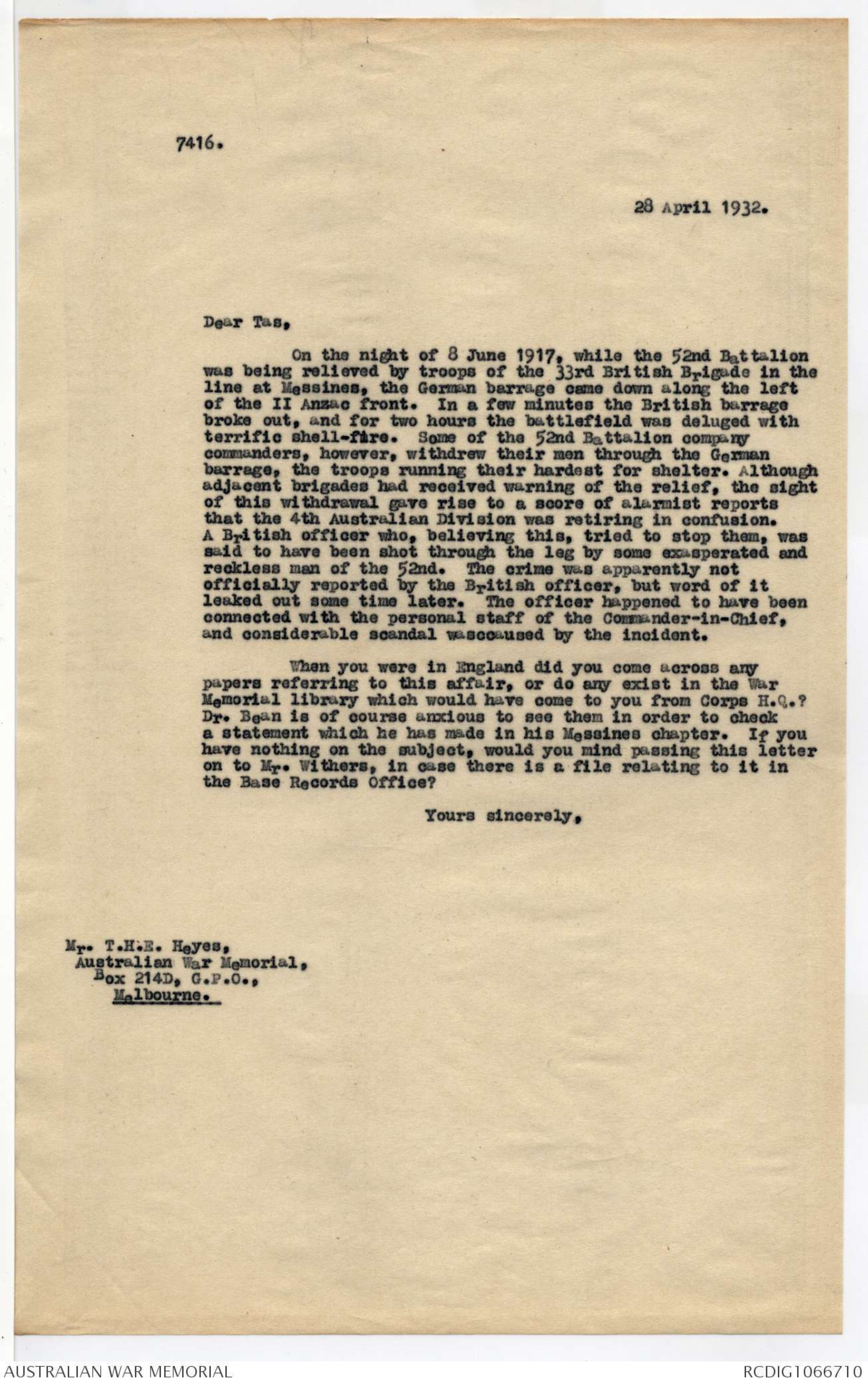
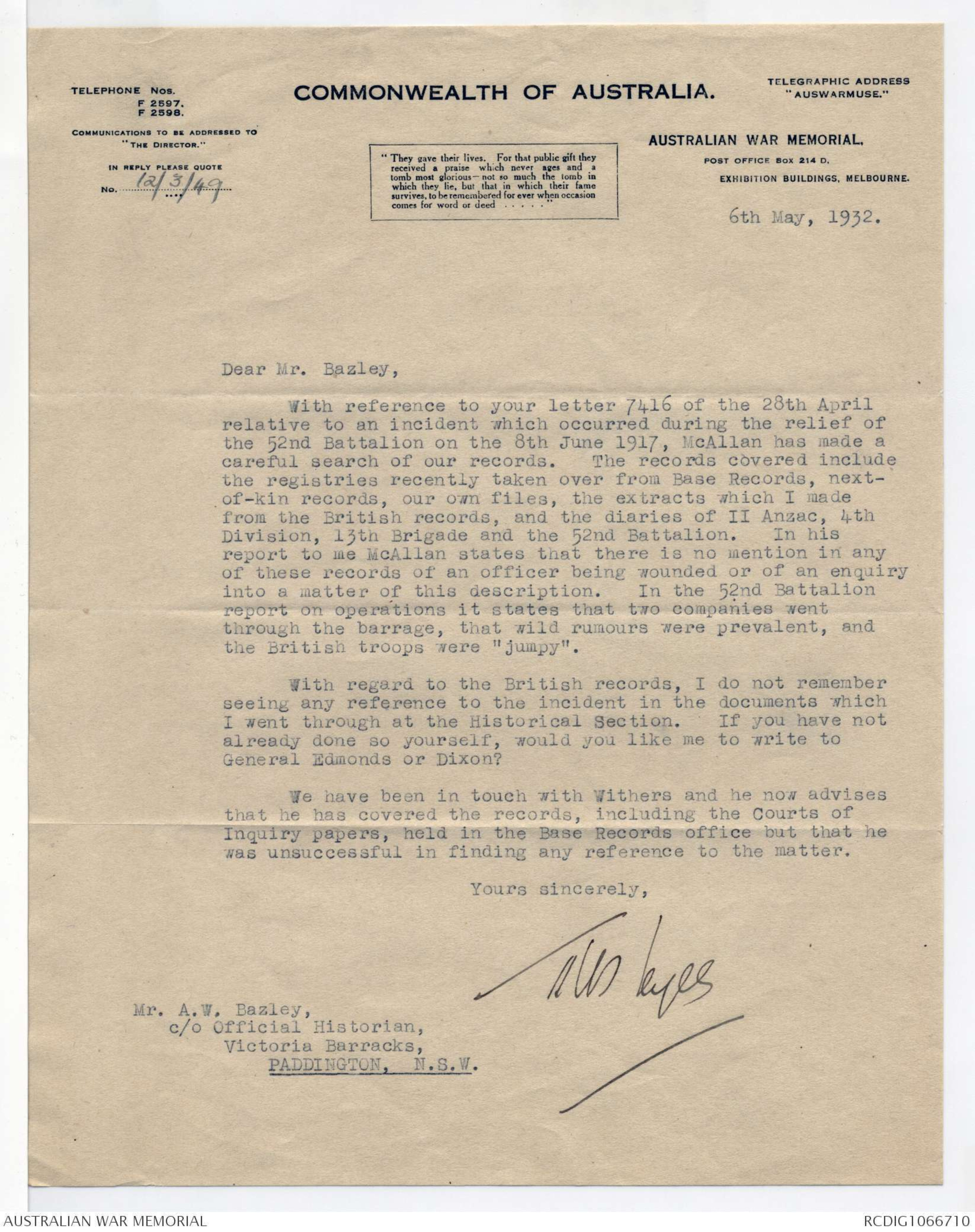
7231.
11 January 1931.
Mrs. C.J. Shang,
215, Lake Street,
Cairns, Q'land.
Dear Madam,
I have to thank you for your letter, and for
returning the draft pages of my manuscript. Is there any
address to which I could write to Mr. Shang?
I return herewith the Base Records papers referring
to Mr. Shang's decorations.
Yours faithfully,
C.E.W. Bean.
7271.
12 February 1932.
Captain N.F. Bremner, D.S.O.
c/o National Bank of Australasia Ltd.,
Brisbane, Q'land.
Dear Captain Bremner,
The official story of the Battle of Messines is about
to go to the printer, but, although Lieutenant Schulz and
Captain Williams have seen it, there remain one or two difficulties
which we cannot settle. The chief one concerns the
message sent by Private Shang, who afterwards received the
D.C.M. A detailed account states that this was sent from
the furthest position just north of Huns' Walk, before the
most advanced troops fell back there, and that it was sent by
flag. The official recommendation says that it was an
improvised-lamp message, which would probably mean that it
was sent a good deal later.
As it seems to have been received before you went
forward to ascertain the position and reorganise, it occurs
to me that you may remember some of these details. If so,
I should be grateful for your assistance.
Yours faithfully,
C.E.W. Bean
Official Historian.
[*Capt Bremner called in at office
& discussed chapter narrative with Dr Bean*]
7219.
22 December 1931.
R.F. Finlason, Esq.. M.C.
366, St. Kilda Street.
Brighton, S.5. Vic.
Dear Sir,
In writing the narrative of the Battle of Messines
for the Official History of the War, I find it recorded that
an officer of the 13th Brigade staff reconnoitred the line of
the 13th Brigade on the evening or night of June 7, 1917. and
brought back the first detailed report of the true position.
General Glasgow and Major Morell think that this officer was
yourself, and I should be grateful if you could confirm this.
Yours faithfully,
C.E.W. Bean
Official Historian.
Ref No 7219
Chillagoe
Post Office
North Queensland
16th Jan. 1932
C. E. W. Bean, Esq.
Victoria Barracks
Paddington N.S.W.
Dear Sir,
In reply to yours of the 22 Dec., referring
to the first detailed report of the position at the Battle of
Messines on the night of June 7, I beg to inform you
that during this operation I was acting I. O. on the
13th Brigade staff & in that capacity furnished
this report.
Yours faithfully
R Finlason
7416.
28 April 1932.
Dear Tas,
On the night of 8 June 1917. while the 52nd Battalion
was being relieved by troops of the 33rd British Brigade in the
line at Messines, the German barrage came down along the left
of the II Anzac front. In a few minutes the British barrage
broke out, and for two hours the battlefield was deluged with
terrific shell-fire. Some of the 52nd Battalion company
commanders, however, withdrew their men through the German
barrage, the troops running their hardest for shelter. Although
adjacent brigades had received warning of the relief, the sight
of this withdrawal gave rise to a score of alarmist reports
that the 4th Australian Division was retiring in confusion.
A British officer who, believing this, tried to stop them, was
said to have been shot through the leg by some exasperated and
reckless man of the 52nd. The crime was apparently not
officially reported by the British officer, but word of it
leaked out some time later. The officer happened to have been
connected with the personal staff of the Commander-in-Chief,
and considerable scandal wasccaused by the incident.
When you were in England did you come across any
papers referring to this affair, or do any exist in the War
Memorial library which would have come to you from Corps H.Q.?
Dr. Bean is of course anxious to see them in order to check
a statement which he has made in his Messines chapter. If you
have nothing on the subject, would you mind passing this letter
on to Mr. Withers, in case there is a file relating to it in
the Base Records Office?
Yours sincerely,
Mr. T.H.E. Heyes.
Australian War Memorial,
Box 214D, G.P.O.,
Melbourne.
TELEPHONE NOs.
F 2597.
F 2598.
COMMUNICATIONS TO BE ADDRESSED TO
"THE DIRECTOR."
IN REPLY PLEASE QUOTE
No. 12/3/49
COMMONWEALTH OF AUSTRALIA.
"They gave their lives. For that public gift they
received a praise which never ages and a
tomb most glorious - not so much the tomb in
which they lie, but that in which their fame
survives, to be remembered for ever when occasion
comes for word or deed....."
TELEGRAPHIC ADDRESS
"AUSWARMUSE"
AUSTRALIAN WAR MEMORIAL,
POST OFFICE BOX 214 D,
EXHIBITION BUILDINGS, MELBOURNE.
6th May, 1932.
Dear Mr. Bazley,
With reference to your letter 7416 of the 28th April
relative to an incident which occurred during the relief of
the 52nd Battalion on the 8th June 1917, McAllan has made a
careful search of our records. The records covered include
the registries recently taken over from Base Records, next-of-kin
records, our own files, the extracts which I made
from the British records, and the diaries of II Anzac, 4th
Division, 13th Brigade and the 52nd Battalion. In his
report to me McAllan states that there is no mention in any
of these records of an officer being wounded or of an enquiry
into a matter of this description. In the 52nd Battalion
report on operations it states that two companies went
through the barrage, that wild rumours were prevalent, and
the British troops were "jumpy".
With regard to the British records, I do not remember
seeing any reference to the incident in the documents which
I went through at the Historical Section. If you have not
already done so yourself, would you like me to write to
General Edmonds or Dixon?
We have been in touch with Withers and he now advises
that he has covered the records, including the Courts of
Inquiry papers, held in the Base Records office but that he
was unsuccessful in finding any reference to the matter.
Yours sincerely,
T H Heyes
Mr. A.W. Bazley,
c/o Official Historian,
Victoria Barracks,
PADDINGTON, N.S.W.
 Sam scott
Sam scottThis transcription item is now locked to you for editing. To release the lock either Save your changes or Cancel.
This lock will be automatically released after 60 minutes of inactivity.